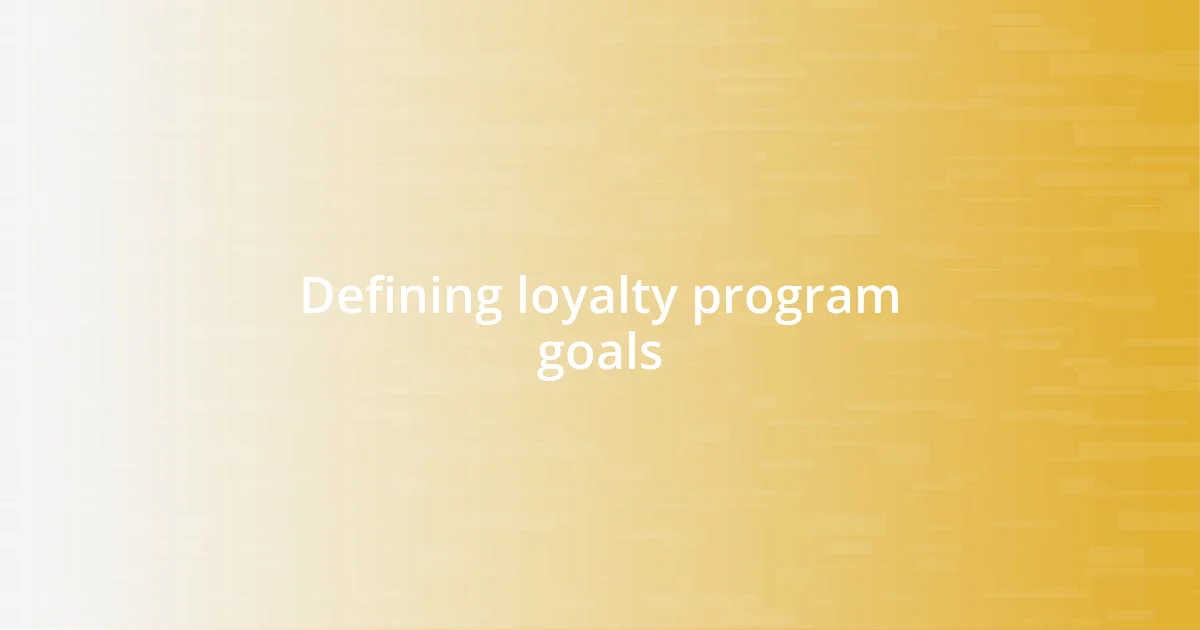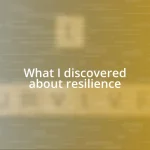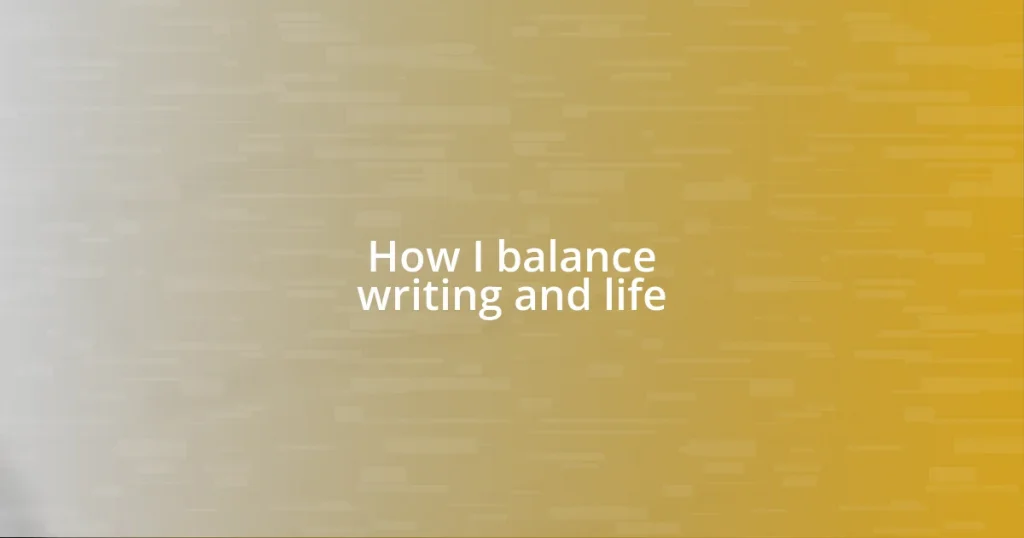Key takeaways:
- Establishing emotional connections by setting goals focused on customer appreciation and advocacy enhances loyalty and boosts both retention and new customer acquisition.
- Implementing customer feedback through surveys and focus groups is crucial for tailoring the loyalty program to actual preferences, resulting in stronger emotional ties and personalized offerings.
- Utilizing technology for tracking, data analysis, and automated communications enriches the customer experience and fosters deeper connections, while promoting the program effectively drives engagement and participation.

Defining loyalty program goals
When defining loyalty program goals, I often reflect on what truly matters to my customers. For me, it’s essential to not just increase repeat purchases, but also to enhance the overall customer experience. Have you ever thought about how a program can make your customers feel valued beyond just the transaction? It’s that emotional connection that often leads to lasting loyalty.
One time, I set a goal to not only boost customer retention but to empower customers to advocate for my brand. I realized that when people feel appreciated, they naturally want to share their positive experiences with others. So, I designed a program that rewards not just purchases but also referrals and social media engagement. The result? A significant uptick in both retention and new customer acquisition, driven by word-of-mouth enthusiasm.
As I crafted these goals, I continuously asked myself: what do I want my customers to feel? I aimed for joy and excitement at each milestone they achieved in the program. That emotional resonance is a guiding principle. Setting clear, heartfelt goals not only aligns my vision for the program but also fosters a deeper connection with customers, making them feel like an integral part of my brand’s journey.

Researching customer preferences
Researching customer preferences is crucial in designing a successful loyalty program. I’ve found that diving deep into customer feedback can unveil preferences that aren’t immediately obvious. For instance, I once gathered insights through surveys and social media polls, only to discover that customers valued exclusive access to new products much more than cash discounts. It was an eye-opener that influenced the direction of my program significantly.
When I initiated focus groups, I realized the importance of listening directly to my customers. It became clear that creating a program tailored to their desires led to a stronger emotional connection. One focus group participant shared how much she cherished special birthday rewards, which sparked an idea for personalized offers. These insights fostered a sense of belonging among my customers, showing that I truly care about their preferences.
In analyzing the data collected, I noticed patterns that guided my decision-making. Establishing a structured comparison enabled me to prioritize the features that mattered most to my customers. This approach not only refined my program but also instilled confidence in my customers that their voices were heard and valued.
| Research Method | Key Insights |
|---|---|
| Surveys | Valued exclusive access over discounts |
| Focus Groups | Personalized offers were crucial for emotional connection |
| Data Analysis | Helped prioritize customer-preferred features |

Designing program structure and rewards
Designing the structure and rewards of a loyalty program is where creativity meets strategy. I vividly remember brainstorming sessions where my team would toss around ideas. We wanted the program to be straightforward yet rewarding. I realized that a tiered system could create excitement and urgency; customers could visualize their journey and strive for higher rewards. This clear progression motivates them to engage more frequently.
Here are some key considerations when structuring your program:
- Tiers: Create levels of rewards that customers can aspire to, each with enticing benefits.
- Variety of Rewards: Offer a mix of rewards—discounts, exclusive products, or experiences—to cater to different customer motivations.
- Ease of Use: Ensure that customers can easily track their progress and redeem rewards without confusion.
- Personalization: Tailor rewards based on individual preferences; a simple survey can help gather this information.
- Experiential Rewards: Think beyond products. For example, I had a great response to offering behind-the-scenes tours, which created memorable experiences for loyal customers.
In my own experience, I once introduced a surprise “thank you” reward—something as simple as a handwritten note with a small gift. The response was overwhelmingly positive. Customers mentioned how this simple gesture made them feel genuinely appreciated, reinforcing their loyalty. It became a pivotal moment for me, highlighting that sometimes, the emotional impact of a reward can be as powerful as its tangible value.

Implementing technology solutions
Implementing technology solutions in your loyalty program can significantly enhance the customer experience. I remember the first time we integrated a mobile app into our program. Suddenly, our customers had a convenient way to track their points and redeem rewards right at their fingertips. It was amazing to see how quickly engagement soared; people love having such instant access. Have you ever thought about how technology can transform mundane tasks into exciting experiences?
Another essential tool I adopted was data analytics software. By studying customer behaviors, I could identify trends and preferences that allowed for a more personalized approach to rewards. One memorable instance was when I noticed a spike in engagement around a specific product category. This insight led us to create exclusive promotions that catered to those interests, fostering a stronger connection with our customers. I found that embracing technology not only streamlined operations but also enriched relationships.
Finally, I’ve seen firsthand the impact of automation in communications. Implementing automated messages for birthdays or anniversaries felt like sending a personal note to each customer. The joy in their responses made me realize that small, thoughtful gestures amplified through technology could strengthen loyalty tremendously. It’s fascinating to consider how the right tech solutions can make your customers feel more valued and appreciated, right?

Promoting the loyalty program
Promoting a loyalty program effectively is crucial for its success, and I’ve found that engaging customers right from the start makes all the difference. When we launched our program, I organized a special event to celebrate and invite our top customers. This personal touch created buzz and excitement. Have you ever seen firsthand how an exclusive launch can get people talking? The energy was contagious, and it built a solid foundation for our marketing efforts.
I also discovered the power of social media in spreading the word about our loyalty program. By sharing testimonials from happy customers, I created relatable content that resonated with potential participants. One story that really stood out was from a customer who earned a dream vacation through our rewards. Hearing her share her journey not only rewarded her but also sparked interest from others. It’s incredible how authentic stories can drive engagement in a way traditional advertising often fails to capture, don’t you think?
Lastly, I realized the importance of consistent communication during ongoing promotions. Sending regular updates via email not only kept our customers informed but also reminded them of the value they had in our program. I had a moment when I sent out a surprise double-points week notification. The influx of participation was exciting, and some customers wrote back expressing how much they appreciated the little surprises. Those interactions reinforced my belief that strategic promotion, coupled with genuine appreciation, can cultivate a loyal community.

Measuring program success
Measuring the success of a loyalty program goes beyond just tracking points redeemed; it’s about understanding the emotional connection customers have to your brand. I vividly remember when we analyzed our retention rates after introducing the program. The metrics showed a significant increase, but what really struck me was the heartfelt feedback we received from participants expressing how valued they felt. Isn’t it remarkable how numbers can reflect genuine customer sentiment?
Another insightful moment came when I started monitoring customer lifetime value (CLV). This metric allowed me to see the long-term impact of our program. I distinctly recall a study we undertook where we discovered that customers engaged in the loyalty program had a CLV nearly double that of non-members. It was an eye-opener! It made me think: how can we further enhance this engagement to elevate their experience even more?
I also experimented with Net Promoter Score (NPS) surveys, asking customers how likely they were to recommend our program to friends and family. The responses provided a wealth of insight. One time, a participant’s enthusiastic endorsement led to a significant surge in new sign-ups—as if her excitement sparked a chain reaction. I find it fascinating to consider how measuring sentiments can guide our strategies and build a community of brand advocates, don’t you?

Adapting strategies based on feedback
Adapting strategies based on feedback has been a game-changer in my journey. I remember when we first rolled out a new feature in our loyalty program, only to find that it wasn’t meeting our customers’ expectations. After some users expressed confusion about how to redeem their points, I felt it was essential to step in and simplify the process. Hearing their concerns reminded me that our loyalty program should evolve with their needs, not just be a static offering.
One approach I particularly cherish is creating open channels for feedback. After our quarterly review, I hosted a casual online gathering where participants could voice their thoughts directly. I was surprised by how many insightful suggestions emerged from those conversations. One customer shared how they wanted more personalized reward options, which sparked a creative brainstorming session that ultimately shaped our offerings. Isn’t it uplifting to see how listening can inspire meaningful change?
I also find that following up on feedback can amplify customer loyalty. For example, after addressing the redemption confusion, I reached out personally to those who had voiced their concerns. I expressed gratitude for their input and informed them of the modifications we made. The responses were incredible—many felt truly valued and connected to our brand. It’s amazing how these little gestures can strengthen relationships, isn’t it?















